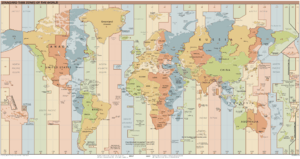Standard time facts for kids
Standard time is a way to make sure all clocks in a certain area, called a time zone, show the exact same time. It helps keep things organized!
Sometimes, when people talk about standard time, they mean the time we use when we are NOT using daylight saving time. Standard time usually happens from autumn until early spring. Then, daylight saving time starts in early spring and lasts until autumn.
Contents
How Standard Time Began
First in Great Britain
Standard time was first used by railway companies in Great Britain. On December 11, 1847, they decided to switch all their train schedules from using local mean time to using Greenwich Mean Time (GMT). This made it much easier to manage train times across the country. By 1855, almost all public clocks in Great Britain were showing GMT.
Standard Time in North America
Before 1883, every town in North America used its own local mean time. Imagine how confusing that was! Train schedules were a big mess because each town had a slightly different time.
A smart person from Canada named Sandford Fleming suggested the idea of standard time. He talked about it at a meeting on February 8, 1879. Later, the people who owned the big railroads met in Chicago. They worked together to create the Standard Time System for trains.
Most states in the United States started using this new system very quickly after the railroads did. The U.S. government officially adopted the system almost 50 years later.
Why Some People Don't Like It
Not everyone is a fan of standard time (or daylight saving time). Some people don't like it because they prefer things to be more natural, like using the sun's position to tell time. They might prefer to use traditional markers like when the sun rises, when it's noon, or when the sun sets.
Others worry that changing the clocks can mess with our bodies' natural sleep and wake cycles, also known as circadian rhythms.
Images for kids
-
Telegraphic equipment used to transmit standard time from the Allegheny Observatory
See also
 In Spanish: Hora estándar para niños
In Spanish: Hora estándar para niños




